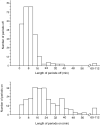No evidence that nest site choice in Pied Flycatchers is mediated by assessing the clutch size of a heterospecific, the Great Tit
- PMID: 34722110
- PMCID: PMC8550018
- DOI: 10.1007/s10336-021-01900-1
No evidence that nest site choice in Pied Flycatchers is mediated by assessing the clutch size of a heterospecific, the Great Tit
Abstract
Among species that use similar resources, an individual may benefit by observing and copying the behavioural decision of a heterospecific. We tested the hypothesis of heterospecific social learning in passerine birds, namely that a migrant species, the Pied Flycatcher Ficedula hypoleuca, uses external markings on the nest cavities of a resident species, the Great Tit Parus major, as cues when choosing a nest site. Others have suggested that prospecting flycatchers assess the clutch size of tit "demonstrators" by entering their nest boxes and, assuming that a large clutch indicates a high-quality individual, will copy the nest appearance of tits with large, but not small clutches. During a 4-year period in Norway, we designed a similar study but did not find that flycatchers based their nest choice on the clutch size of tits. Neither were there any relationships between clutch size of the tit and its laying date, incubation behaviour, or the number of eggs visible through nest material during egg-laying so Pied Flycatchers did not use these indirect cues to assess quality of the tutor. Filming of tit nests showed that prospecting flycatchers did not enter tit nest boxes to assess the content. Indeed, incubating female tits only left their nest boxes for short bouts of unpredictable duration so there was little opportunity for flycatchers to inspect the nest contents unnoticed. Our study calls into question the mechanism of using the content of tit nests as public information for choosing traits of nest sites based on external characteristics. We suggest that similar studies of nest site choice in relation to possible social information transfer be replicated more widely.
Keine Belege dafür, dass Trauerschnäpper ihren Nistplatz aufgrund einer Einschätzung der Gelegegröße einer anderen Art, der Kohlmeise, auswählen. Wo Arten ähnliche Ressourcen nutzen, kann es für ein Individuum vorteilhaft sein, das Entscheidungsverhalten eines Artfremden zu beobachten und zu kopieren. Wir prüften die Hypothese des heterospezifischen sozialen Lernens bei Singvögeln, hier konkret, dass eine Zugvogelart, der Trauerschnäpper Ficedula hypoleuca, äußere Kennzeichen an den Nisthöhlen einer Standvogelart, der Kohlmeise Parus major, als Entscheidungshilfen bei der Nistplatzwahl nutzt. Andere Autoren haben vermutet, dass auskundschaftende Fliegenschnäpper die Gelegegröße der als Vorbild dienenden Meise einschätzen, indem sie in den Nistkasten schlüpfen und in der Annahme, dass ein großes Gelege ein Individuum von hoher Qualität signalisiert, ihr Nestäußeres an dem von Meisen mit großen, nicht jedoch kleinen Gelegen ausrichten. Über einen Zeitraum von vier Jahren entwickelten wir in Norwegen eine ähnliche Studie, konnten aber nicht feststellen, dass die Fliegenschnäpper ihren Nistplatz anhand der Gelegegröße der Meisen auswählten. Ebenso wenig gab es Zusammenhänge zwischen der Gelegegröße der Meise und dem Legedatum, Brutverhalten oder der Anzahl der während der Eiablage durch das Nistmaterial hindurch sichtbaren Eier, so dass die Trauerschnäpper diese indirekten Hinweise auf die Qualität ihres Vorbildes nicht nutzten. Filmaufnahmen von Meisennestern zeigten, dass die auskundschaftenden Fliegenschnäpper nicht in die Nistkästen schlüpften, um den Inhalt zu begutachten. Tatsächlich verließen die brütenden Meisenweibchen ihre Nistkästen nur für kurze Zeiträume unvorhersehbarer Dauer, so dass die Fliegenschnäpper wenig Gelegenheit hatten, den Nestinhalt unbemerkt in Augenschein zu nehmen. Unsere Untersuchung stellt den Mechanismus infrage, dass der Inhalt von Meisennestern als frei zugängliche Information dient, um Nistplatzeigenschaften anhand von äußeren Merkmalen auszuwählen. Wir empfehlen, ähnliche Studien zur Nistplatzwahl im Hinblick auf möglichen sozialen Informationstransfer in größerem Rahmen zu wiederholen.
Keywords: Egg covering; Ficedula; Nest site preferences; Parus; Social learning; Tutor.
© The Author(s) 2021.
Conflict of interest statement
Conflict of interestsThe authors declare that they have no conflict of interest in the authorship of this article.
Figures




Similar articles
-
Egg covering in cavity nesting birds may prevent nest usurpation by other species.Behav Ecol Sociobiol. 2021;75(8):116. doi: 10.1007/s00265-021-03045-w. Epub 2021 Jul 31. Behav Ecol Sociobiol. 2021. PMID: 34759442 Free PMC article.
-
Nest site preference depends on the relative density of conspecifics and heterospecifics in wild birds.Front Zool. 2017 Dec 20;14:56. doi: 10.1186/s12983-017-0246-5. eCollection 2017. Front Zool. 2017. PMID: 29270207 Free PMC article.
-
Conceptual preferences can be transmitted via selective social information use between competing wild bird species.R Soc Open Sci. 2022 Jun 15;9(6):220292. doi: 10.1098/rsos.220292. eCollection 2022 Jun. R Soc Open Sci. 2022. PMID: 35719877 Free PMC article.
-
Adaptive coloration in pied flycatchers (Ficedula hypoleuca)-The devil is in the detail.Ecol Evol. 2021 Jan 24;11(4):1501-1525. doi: 10.1002/ece3.7048. eCollection 2021 Feb. Ecol Evol. 2021. PMID: 33613985 Free PMC article. Review.
-
Predators and the breeding bird: behavioral and reproductive flexibility under the risk of predation.Biol Rev Camb Philos Soc. 2009 Aug;84(3):485-513. doi: 10.1111/j.1469-185X.2009.00085.x. Biol Rev Camb Philos Soc. 2009. PMID: 19659887 Review.
Cited by
-
Bird nest building: visions for the future.Philos Trans R Soc Lond B Biol Sci. 2023 Aug 28;378(1884):20220157. doi: 10.1098/rstb.2022.0157. Epub 2023 Jul 10. Philos Trans R Soc Lond B Biol Sci. 2023. PMID: 37427469 Free PMC article. Review.
References
-
- Álvares E, Barba E. Within and between population variations of incubation rhytm of Great Tits Parus major. Behaviour. 2014;151:1827–1845. doi: 10.1163/1568539X-00003218. - DOI
-
- Aplin L. Understanding the multiple factors governing social learning and the diffusion of innovations. Current Opinion in Behavioral Siences. 2016;12:59–65. doi: 10.1016/j.cobeha.2016.09.003. - DOI
-
- Avarguès-Weber A, Dawson EH, Chittka L. Mechanisms of social learning across species boundaries. J Zool. 2013;290:1–11. doi: 10.1111/jzo.12015. - DOI
LinkOut - more resources
Full Text Sources
